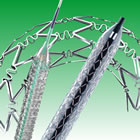|
Presented this morning in Munich by Dr. William Wijns at the 2012 Annual Meeting of the European Society of Cardiology, the results of the PROTECT trial (Patient Related OuTcomes with Endeavor versus Cypher Stenting Trial) showed low stent thrombosis rates at three years for both the Cypher sirolimus-eluting stent (1.79%) and the Endeavor zotarolimus-eluting stent (1.42%). The study was published simultaneously in The Lancet. Only Study Powered to Measure Stent Thrombosis in Real-World Patients The DES Firestorm of ESC 2006 The presentations at ESC 2006 prompted great worry among the cardiology community and prompted disturbing news coverage in the popular press; for example, Robert Bazell, NBC's chief science and health correspondent, wrote that "Millions of Americans could be walking around with tiny time bombs in their hearts." In response to these fears and news, the FDA convened an extraordinary two-day panel in December of 2006 to address these issues, obtain the latest data from the stent manufacturers, and to make recommendations to the medical community and the public as to any changes in treatment protocols. (To understand first-hand the frightening effect of the media coverage, read the testimony of the only stent patient to testify at the hearings, a member of Angioplasty.Org's Forum who heard about the meeting from this web site.) One of the biggest problems at the FDA hearing was the lack of long-term data in large numbers of "real world" patients: patients with complex situations, multivessel disease, bifurcation lesions, diabetes, etc. Most clinical trials were designed to gain approval for a specific device -- and the numbers required to show efficacy were around 1,000 patients or so. So-called "on label" indications were for relatively uncomplicated de novo lesions. FDA panel members took Johnson & Johnson to task for only following the initial Cypher stent patient cohort for nine months. Although Boston Scientific, the only other device manufacturer with an approved DES, presented more data, it still was not sufficient to determine if there was a significant problem, whether the problem continued in patients after a year or more and, if so, what to do about it. Panel Recommendations in the Absence of Hard Data Public and Professional Fears Lead to a Decrease in Drug-Eluting Stent Use The controversy about stent thrombosis bubbled over even within the interventional cardiology community, for example, at the 2006 TCT Meeting (see "Stent Wars Across the Atlantic: USA vs. Europe"). A number of interventional cardiologists felt that drug-eluting stents had gotten a "bum rap," that they were better than bare metal stents and that the benefits greatly outweighed the small increased risk. But the problem remained that there were many conflicting studies, and none of them were large enough or designed expressly to measure the frequency of stent thrombosis. Medtronic Steps In Now six years later, the initial three-year results have been adjudicated and the question of whether drug-eluting stents pose a significantly increased risk of death or heart attack has been answered: No! These devices are not "tiny time bombs" and the incidence of stent thrombosis is no different than that seen in bare metal stents. The study investigators are continuing to monitor the patient population of PROTECT and longer term outcomes will be available in the future. Cypher and Endeavor: Rates of Stent Thrombosis Diverged After DAPT Stopped The import of this statistic can be seen when looking at the levels of dual antiplatelet therapy (DAPT). For the first year, DAPT adherence was 95%. It dropped to 36% in year two and 30% by year three. As DAPT usage dropped, the incidence of stent thrombosis for the Cypher stent increased, while stent thrombosis in the Endeavor was virtually flat. The conclusion is that longer DAPT in the first-generation DES, like Cypher, is necessary -- and that stent thrombosis, while low in incidence, continues to occur even at three years -- something that did not occur in the newer (at the time) Endeavor. Out With the Old; In With the New Whether longer-term usage of dual antiplatelet therapy is still necessary is a question that hopefully will be answered by the DAPT trial, which compares 12 to 30 months of DAPT in all current DES. However, a question that will not be answered by the DAPT trial is whether periods of less than a year may be equally safe in the second and third generation drug-eluting stents. Newer devices, combined with better management of and adherence to antiplatelet medications, better patient selection, and more effective interventional techniques and strategies, such as high-pressure balloon inflation and more complete stent expansion, have all contributed to reducing what was once feared as the Achilles' heel of drug-eluting stents. Technology continues to advance with biodegradable stents, drug-eluting balloons and other devices, but for now, the data from the PROTECT study should put to rest many of the concerns of the past about drug-eluting stents. Reported and updated by Burt Cohen, August 27, 2012 |

